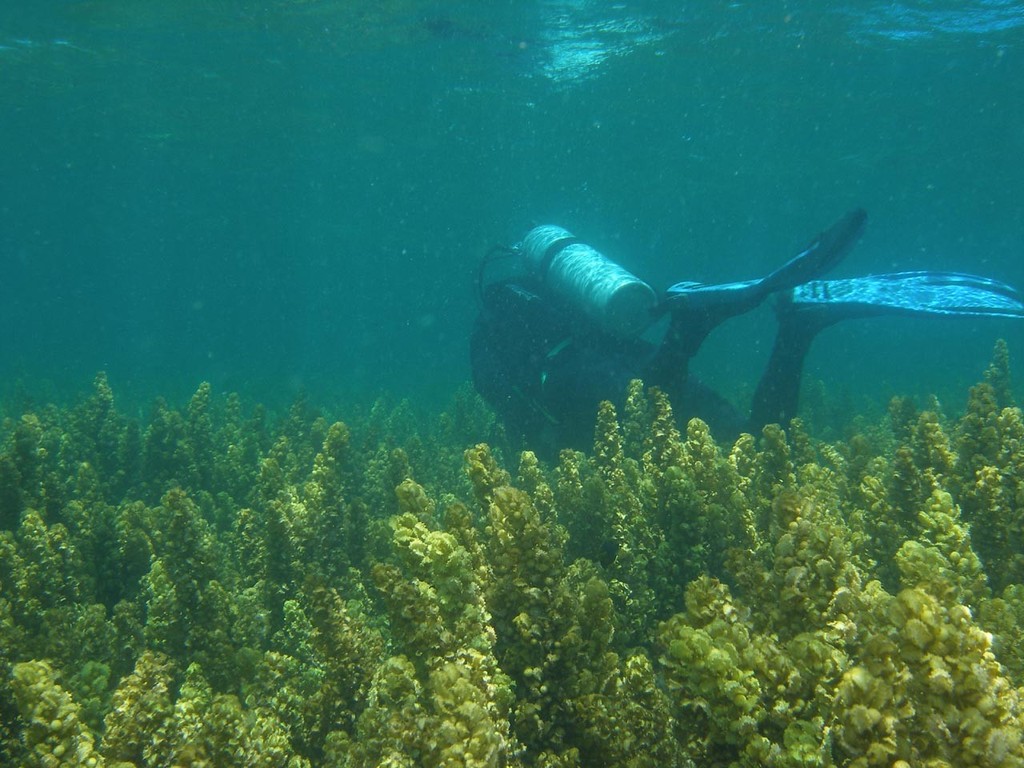Weeds submerge Inshore Reefs
by ARC Centre of Excellence for Coral Reef Studies on 9 Jan 2010

Sargassum stands on an inshore reef in the Turtle Group off the mainland in the Lizard Island region ARC Centre of Excellence Coral Reef Studies
http://www.coralcoe.org.au/
A new scientific study has found that seaweeds have claimed large areas of the coastal shelf of Australia’s Great Barrier Reef (GBR).
Part of a global effort to record and understand changes in coral reefs worldwide, the study has found that more than 40 per cent of inshore reefs on the GBR are dominated by seaweeds (macroalgae) – but that the mid-shelf and outer reefs are virtually free of weed.
'The Great Barrier Reef is widely regarded as the world’s most intact large reef system – and that’s the way we aim to keep it,' says Professor Dave Bellwood of the ARC Centre of Excellence for Coral Reef Studies and James Cook University. 'As part of that goal, it is important to study what makes up the reef, in order to monitor any changes that may occur and understand what is causing them.'
Worldwide, many scientists consider that a shift from coral-dominated reefs to weed-dominated reefs signals a decline in the health of coral ecosystems – and is exceptionally difficult to reverse. Much therefore depends on keeping coral-dominated reefs in as weed-free a condition as possible, Prof. Bellwood suggests.
'We carried out two major censuses in the northern and central regions, sampling reefs close to the shore, in the mid GBR lagoon, and on the outer GBR, in which we swam more than 500 10-metre transects, taking careful note of the reef composition.
Seaweed cover was greatest on inner-shelf reefs – around 43 per cent per cent were dominated by weeds – and decreased markedly to around 4 per cent on mid-shelf and outer-shelf reefs in both regions of the GBR.
'We got quite a shock when we saw how much of the inner reefs were dominated by weed,' Prof Bellwood – who has dived the GBR for several decades – admits. 'Forty-three per cent is a surprisingly big number – but it is their natural state or not? There is a lack of historical data to tell us for sure. It needs close scrutiny to find out.'
He called on Australians who may have been photographing inshore reefs since the 1950s to provide whatever pictorial evidence they may have of weed and coral cover, provided the photos are clearly dated and the location they were taken is known. This may help scientists establish whether the seaweed is on the increase or not.
As yet there is much to learn about what causes reefs to become dominated by algae, although nutrients from the land are one suspect and herbivorous fish are unquestionably an important factor in keeping weeds in check.
'In our survey the corals of the mid-shelf reefs were in much better condition – and one of the things we can clearly do is make sure they stay that way. It would be tragic if macroalgae started to spread on them,' he adds.
Key to this, Prof. Bellwood says, is maintaining strong populations of browsing and grazing fishes, like parrot, surgeon, rabbit and bat fish, which keep the weeds down by ‘mowing’ them and preventing them from getting a foothold. 'There is overwhelming scientific evidence from Australia and round the world to show that herbivores are vital to the overall health of coral reefs,' he adds.
However Australia has no legislation to protect this vital group of fishes and their central role in helping to conserve the Great Barrier Reef.
Prof. Bellwood has written to the Rudd Government suggesting the need for a national policy – but has yet to receive a positive reply.
'This is a win-win politically, as well as for the environment,' he says. 'Protecting Australia’s herbivorous fishes would offend few people – but would have major benefits in keeping our reefs clean and healthy and so supporting the $5 billion in activities that rely on them.'
Finally, Prof. Bellwood urges those diving the reef to visit the weedy inshore reefs: 'They aren’t all coral, but they can be spectacularly beautiful in their own way, and you will see a mix of species inshore that you can see nowhere else. In my eyes they rival anything you can see in a dive on the outer barrier reef – yet they are so much easier to gain access to.'
For those who regularly dive the inshore reefs and take pictures, Prof Bellwood, urges them to keep careful records of date and place. 'We really need to know whether or not these reefs are changing, and how fast. If anyone has records going back to the 1950s, that would be brilliant.'
The scientific paper 'Cross-shelf benthic community structure on the Great Barrier Reef: relationships between macroalgal cover and herbivore biomass' by Sharon Wismer, Andrew S. Hoey and David R. Bellwood, appears in Marine Ecology Progress, Vol. 376: 45–54, 2009.
http://www.coralcoe.org.au/
If you want to link to this article then please use this URL: www.sail-world.com/65281